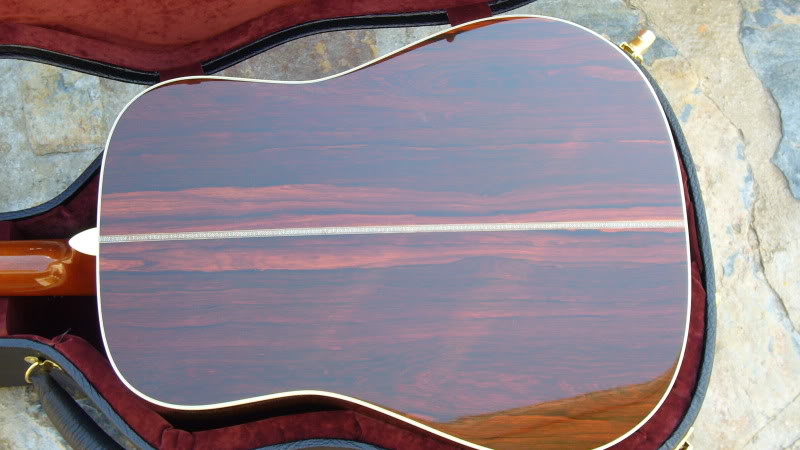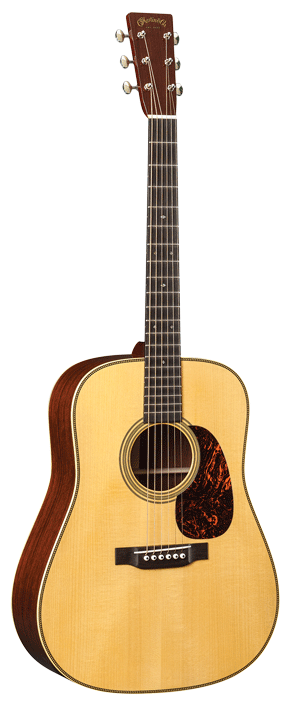
Martin D28 rosewood back and sides
Repair Log: 1998 Martin D28 rosewood back and sides, figured spruce top dreadnought SN: xxxxxx
23/06/18 Copyright retained Terry Relph-Knight
New D28s list at $3,299
Current value – £1,089 to £1,479
Supplied with a Martin ABS hard case.
Serial number is on the inside face of the heel block.
A classic Martin D28 14 frets to the body, with one piece mahogany fake bridal joint dart neck, with rosewood headstock veneer, rosewood fret board (20 narrow frets, mother of pearl dots) and bridge, bone nut and saddle and Indian rosewood back and sides. The guitar has had a headstock repair at some point. A small crack is visible just below the volute and the area has been over sprayed in a dark brown. Top is of highly figured spruce with a black scratch plate. I contacted Martin and they confirmed the date of the guitar, but said they had no special notes on its construction and that the highly figured top must just be luck of the draw. 6 ply binding/purfling back and front of the body. The two piece rosewood back has a dash pattern centre stripe. The Martin name and est. in 1833 is stamped on the top of the headstock in gold ink.
The 6 white bridge pins look fancy with a central abalone dot, but they are in fact soft plastic.
Bone nut and saddle. The saddle may have been replaced since it does stand quite high and contributes to the high action. Removing the saddle from the bridge reveals a pencil line 2mm above the bottom, so it looks as though it was marked to be cut down, but the cut was never made.
The guitar has a high action due to a combination of a belly bulge and the high saddle. If, as suspected, the high saddle is a replacement that was never cut down then this itself will put extra tension on the top and be contributing to the degree of belly bulge.
The bridge has been drilled at either end for an under saddle pickup and the body is fitted with a wooden end pin with circumferential scratches in the finish, well below the waist of the pin. This may indicate that the guitar was at one time fitted with an under saddle pickup and an end pin jack which have now been removed. This would explain why the saddle had perhaps been replaced and never properly fitted.
Martin D28 rosewood back and sides Repair Log
A tap test on the body shows it is very lively and resonant. As you might expect the back has higher, harder pitch than the boomier front.
Stamped onto the liner strip that spans the join between the two halves of the back is the instruction – USE MEDIUM GAUGE STRINGS OR LIGHTER ONLY
Small sealed chrome plated tuners branded Martin, probably made by Ping.
The truss rod adjusts inside the body at the end of the fret board, accessed via a cut out in the top brace just inside the soundhole. A large L Martin 3/16 inch hex key is usually required (supplied in the case). Owner says this is jammed – he is right, it won’t move.
Problems – High action. Needs a good clean. Is missing the heel cap. The guitar has a fair bit of belly lift. We agreed the first thing to try would be to lower the saddle by 2mm (fit a new saddle and keep the old one just in case). Owner likes ease of play and a bright punchy sound so agreed to fit a set of Elixir 11 to 52 bronze. These are light gauge for acoustic so they will put less stress on the top and feel easier and slicker to play. The brass wound strings gives them a brighter sound.
Work done – Replaced the original bone saddle with a Graph Tech saddle shaved to produce the 2mm height reduction and lower action. Fitted a set of brass bridge pins replacing the old plastic pins. Brass pins are harder wearing and add a little mass, improving sustain. Soft plastic pins damp some of the string vibration. Cut and glued on a new rosewood heel cap. Cleaned and polished the body and neck. Checked the fretboard for high frets, buffed the frets and cleaned and oiled the fretboard. Loosened the jammed truss rod, lubricated the truss rod nut and re-adjusted for a little forward bow. Fitted a set of 10 to 47 Elixir (bronze) brass winding on the wound strings.
Straightened the bend out of the case lid, cleaned the outside of the case and vacuumed dust and grit out of the inside.
Analysis –
This guitar does seem to have a particularly flexible top and it may at some point have been fitted with heavy strings, which Martin warns against with the internal stamp – USE MEDIUM GAUGE STRINGS OR LIGHTER ONLY. This may account for the belly bulge (see below).
Rosewood back and sides 1998 Martin D28
Evidence suggests that at some point it may have been fitted with an under-saddle pickup, with the original saddle shortened. If so the pickup has been removed and the saddle has probably been replaced with a new saddle that was never trimmed to height for the correct action.
The guitar has a fairly pronounced belly bulge and the bridge noticeably tilts forwards. With the strings off and therefore tension off the guitar most the bulge relaxes and the bridge and top flattens out. None of the bracing seems loose. A JLD Bridge Doctor could be fitted to completely remove the bulge.
Even without the belly bulge the action seems a little high. With only the low E string replaced and measured ‘open string’ there is 7/64s of an inch between the top of the twelfth fret and the bottom of the string.
Apparently the Martin guitar factory considers the action to be within specification if the distance from the 12th fret to the bottom of the low E string is between 2.38 mm (3/32″) minimum, to 2.78 mm (7/64″) maximum. So without the belly bulge this guitar would meet that spec.
The high ‘e’ treble string should measure between 1.59 mm (1/16″) and 1.98 mm (5/64″) at the maximum.
Fitted with the 10 to 47 Elixir and with the new saddle lowered, the guitar meets the Martin specification, Low E is at 7/64 and the high E is at 1/16.
The truss rod was adjusted so the neck was dead flat, there may even have been a little back bow. The owner says he has tried adjusting the truss rod, but it seems jammed and won’t move. Eventually managed to unscrew it (anti-clockwise). It had been turned clockwise as tight as it could go, probably in an effort to reduce the high action. Seems to be a single action rod and the adjustment nut feels like it will come off altogether. It does – hex tube or rod nut 9mm diam by 30mm long. I lubricated it with a little grease in the threads and replaced it. Tightened it by 2/3rds of a turn from slack.
Martin Acoustic strings run from 10 to 47 extra light, through 11 to 52 custom light and 12 to 54 light, up to 13 to 56 medium. String makers seem to have stopped using the description ‘heavy’ for strings, so ‘medium’ is now the old ‘heavy’.
As delivered the guitar was fitted with a set of
0.011, 0.016, 0.025, 0.032, 0.042, 0.054
Re-strung with Elixir 80/20 Bronze Nanoweb
0.010, 0.014, 0.023, 0.030, 0.039, 0.047
It will have less bulge and be easier to play with the set of 10 to 47 as detailed above.







